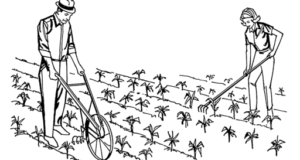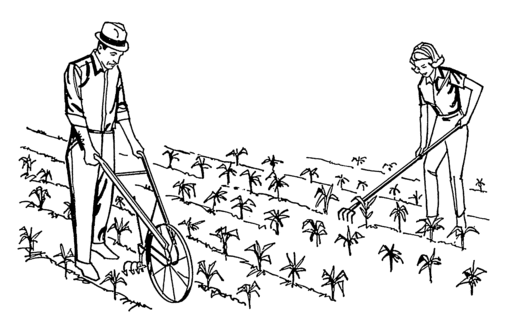 My mother’s vegetable garden was a formidable opponent. It spanned over a quarter of an acre and included almost every vegetable you could think of, plus a prolific berry patch. The garden was flanked on one side by a wooded gully. On the other side was a field for the horses. The sheer size of the garden meant some serious annual tilling and soil preparation. Once the garden was planted, its proximity to uncultivated land meant constant battle against the weeds that drifted over or were carried in by animals.
My mother’s vegetable garden was a formidable opponent. It spanned over a quarter of an acre and included almost every vegetable you could think of, plus a prolific berry patch. The garden was flanked on one side by a wooded gully. On the other side was a field for the horses. The sheer size of the garden meant some serious annual tilling and soil preparation. Once the garden was planted, its proximity to uncultivated land meant constant battle against the weeds that drifted over or were carried in by animals.
Why my mother didn’t have a gas-powered tiller, I don’t know. Frugality, probably. But we plowed the soil every spring with an old-fashioned hand tiller. We used this same contraption to cut down weeds between the rows during the growing season. It had a large wheel in front and some slightly rusted tines behind. Two long handles rose from the wheel. We were, of course, the only family in the area that gardened in such an old-fashioned manner. I often groaned loudly about working in the garden. I was sure that none of my friends were forced into such sweaty, demanding toil.
Then, I grew up and got my own garden. I bought a fancy tiller. I’ve got a shed full of modern tools. Guess what I discovered: gas-powered tillers are work, too. Sure, they can till a large garden more quickly than a hand tiller, but in the time it takes to put in the gas, clean them off and get them started after a long winter in the shed, I can plow up a considerable amount of garden space with a hand tiller. I’m not mechanically minded, so I love the simplicity of hand gardening equipment. You can see all the parts, you know how the machine works, and if there’s a problem, it’s easy to fix.
From an aesthetic perspective, hand tillers are an entirely different experience than gas-powered equipment. For one thing, they’re quiet. They make no noise, beyond a gentle scraping and whirring. They don’t have the same bone-jostling intensity of a power machine. I’m more aware of the conditions in my garden as I’m using hand-powered machines because they require less intense focus. I’ve also usually got one of two of my young children straggling behind me in the garden – a situation that causes a certain amount of anxiety when I’m using a gas-powered machine. Although hand-operated machines still require careful care, the possibility for accident is greatly reduced.
It’s designed to help anyone (beginner or expert), cultivate a highly productive crisis garden.
Forget the infomercials offering new gardening inventions. In most cases, these products are unreliable and poorly made. The tools that have been used for hundreds of years are still the best tools for your garden. They were developed by early settlers who relied on their gardens to feed their families. These tools were designed for heavy work, year after year. And best of all, if tough times fall, you don’t have to worry about finding gas or oil or any expensive components to keep them operational. Below are descriptions of a few tools that might interest you and where to find them.
Hand Tillers
When it comes to hand tillers, you’ve got several options. Heavy-duty tillers are designed to plow the ground in preparation for gardening. Other tillers are good for removing weeds after the garden is planted. Most have one wheel in the front with the tines following behind. Some products have two sets of tines—one for plowing the field and making furrows, and one for disposing of weeds. The HOSS Wheel Hoe is an exact replica of the Planet Junior cultivator, a common fixture in gardens throughout the early 1900s. This machine has a large front wheel and the classic hand tiller design.
A double-wheel hoe has two small wheels and a narrow set of tines for quick and easy weeding. One clever product, the Flip and Go Cultivator, has plowing tines on one side and cultivating tines on the other. Simply turn the tiller over, depending on your gardening need.
A rotary cultivator doesn’t have a wheel at all, but rather, a moving barrel similar to a push lawn mower. The barrel moves over the weeds, cutting them down. Tines behind the barrel dig up the roots and remaining weeds.
Hand Seeders
Hand-operated seeders are another old-time piece of machinery worth considering if you have a large garden. For small vegetable gardens, a Glaser Seeder is a good choice. This machine resembles a wheeled hoe, but you pull it behind you. The seeder has a plastic hopper and is adjustable for three seed sizes. A small wheel behind the hopper tamps the earth down behind the seeds.
Those with large vegetable gardens will prefer the Four-Row Pinpoint Seeder. This tool also resembles a hoe and is pulled behind you. It contains four compartments that deliver seeds in four rows spaced 2 ¼ inches apart. Alternatively, you can opt for two rows, spaced either 4 ½ inches apart or 6 ¾ inches apart. This product also is adjustable to accommodate various seed sizes.
Buying Equipment
My mother’s tiller looked like it was an original. The handles were weathered and worn and the wheel was pitted and somewhat rusted. She probably picked it up for a pittance at a yard sale or farm sale, which is still a great place to look for old tools. Craigslist is another good source for farm and garden tools.
If you want to buy new, start with your local hardware store or garden center. As the popularity of organic gardening rises, more and more vendors are carrying old-fashioned hand tools. If you can’t find these products in your local market, check a good gardening or hardware catalog.
Cottage Craft Works is a veritable emporium for anyone interested in the homesteading lifestyle. This mail-order business carries not only tillers and garden tools, but also kitchen and canning equipment, furniture, and homeschooling books.
And, of course, Lehman’s Hardware, the famous Amish hardware store, carries hundreds of gardening items, along with other household supplies.
Hand tillers, seeders, and tools aren’t always cheap, but they’ll probably last you a lifetime. Look for sturdy steel tines and handles made from fiberglass or fired ash. Chances are, you’ll soon develop a preference for the simplicity and beauty of hand machines.
©2013 Off the Grid News












